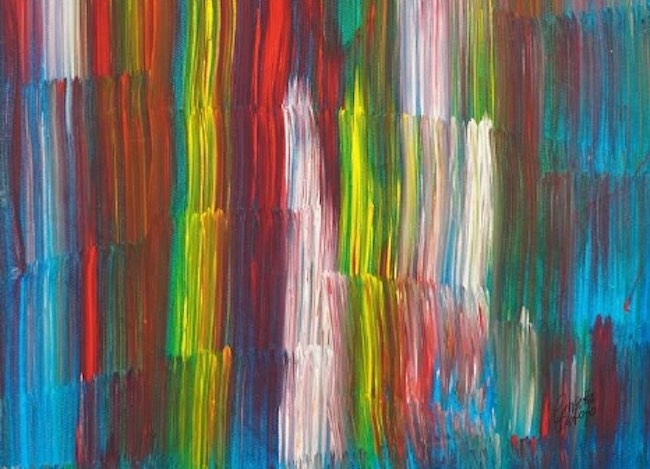I percorsi dell’esistenza costituiscono spesso la modalità attraverso la quale un artista si avvicina all’arte, a volte svelando le sue qualità caratteriali e altre invece celandole, sulla base dell’atteggiamento nei confronti della realtà, dell’oggettività, che ciascun creativo ha; laddove alcuni hanno bisogno di razionalizzare ogni piccola circostanza altri invece preferiscono studiare l’osservato per comprendere meglio se stessi e il mondo che ruota intorno. Così come vi sono quelli che necessitano di avere un approccio completamente analitico e scientifico mentre altri si liberano completamente da ogni timidezza o remora espressiva solo nel contatto impulsivo e spontaneo con la tela. La protagonista di oggi appartiene all’ultimo gruppo, quello per cui il rapporto con la pittura è manifestazione del sé più profondo che trova nei colori e nella sperimentazione artistica la vera essenza rivelando lo sguardo con cui si pone nei confronti dell’esistenza.
Il percorso espressivo del Ventesimo secolo è stato un costante susseguirsi di innovazioni, di avanguardie e di sperimentazioni che in tutta l’arte precedente, assolutamente legata alle regole classiche e accademiche, non avevano mai potuto attuarsi; i limiti imposti da una tradizione pittorica millenaria, la ricerca della perfezione formale e della resa della realtà osservata, furono completamente spezzati davanti all’esigenza di nuovo che stava travolgendo come un’onda tutto il mondo culturale dell’Europa di inizi Novecento, sospinta dalle modificazioni radicali che la società stava compiendo ma soprattutto dal desiderio degli artisti di trovare nuova linfa vitale necessaria ad alimentare una creatività che non voleva più sottostare ad alcuno schema o regola. L’Espressionismo sottolineò il desiderio di alcuni di abbandonare la perfezione rappresentativa per rivolgersi a un’interiorità troppo a lungo ignorata, se non per qualche eccezione, fino alla fine dell’Ottocento, determinando dunque una rinuncia al bello estetico in favore di una predominanza dell’emozione forte, intensa, persino travolgente a volte. Questa tendenza trovò inizialmente opposizione e ostacoli nei salotti culturali dell’epoca, ma poi grazie alla tenacia di grandi maestri del genere, come Henri Matisse, André Derain, Edvard Munch, James Ensor, le chiusure furono abbattute e il movimento diventò predominante negli inizi del Ventesimo secolo. Ma l’innovazione di quel periodo spingeva anche verso a una rinuncia completa della forma visibile, di una riproduzione della realtà che troppo aveva dominato in precedenza e che doveva ora confrontarsi con i nuovi mezzi tecnologici che si andavano affermando come la fotografia e il cinema. Così un altro gruppo di artisti trovò il modo di affermare la supremazia dell’arte sopra ogni cosa, decretando la nascita dell’Arte Astratta, declinata in Astrattismo Lirico, De Stijl, Suprematismo Russo, Costruttivismo, Astrattismo Geometrico, dove però ciò a cui i maestri come Piet Mondrian, Kasimir Malevic e Josef Albers tendevano era la completa rinuncia alla soggettività dell’autore, al distacco emozionale per sottolineare la perfezione del gesto plastico epurato da ogni sensazione. Tuttavia escludere il mondo interiore non generava sufficiente coinvolgimento nel pubblico così negli Stati Uniti degli anni Cinquanta, un gruppo di artisti capitanato da Jackson Pollock decise di permettere all’Astrattismo di riappropriarsi dell’emozione, dando vita all’Espressionismo Astratto, dove persino l’azione del dipingere divenne per la prima volta parte della tela e in cui la libertà stilistica era una delle linee guida del movimento. Ciò che contava sopra ogni altra cosa era trasmettere sull’opera l’interiorità trattenuta e a volte incapace di trovare un linguaggio tanto esplicito come quello pittorico, a dispetto dell’indefinitezza delle immagini; è esattamente questo il percorso che contraddistingue l’artista calabrese Concetta Cantafio che sceglie a sua volta l’Espressionismo Astratto per dare concretezza a tutte le sensazioni che riceve dalla realtà intorno a sé e che vengono filtrate dal suo approccio positivo alla vita.
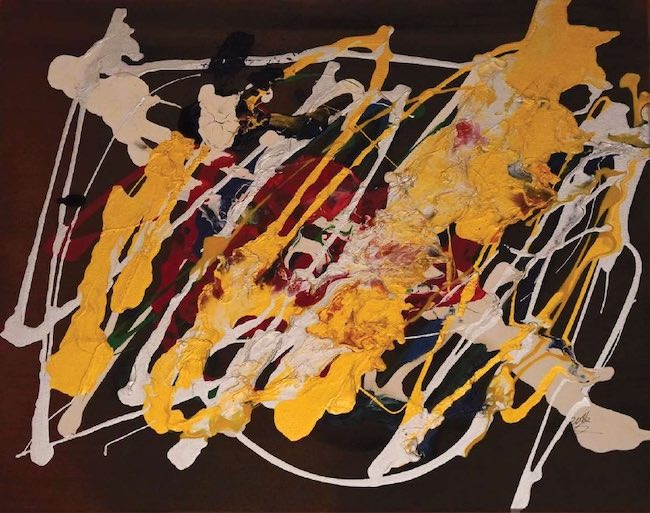
Ma la sua esigenza creativa, contraddistinta da una marcata poliedricità, la spinge a misurarsi non solo con il puro impulso pittorico che la pone sullo stesso livello istintivo di Pollock, bensì anche con la materia che deve essere plasmata e assecondata al suo istinto generando opere di forte impatto a volte contraddistinte da una gamma cromatica più scura, sottolineando quanto l’esistenza sia anche portatrice a volte di ombre che vanno affrontate, guardate negli occhi e solo in un secondo momento risolte, mentre altre caratterizzate da maggiore luminosità e da una scelta coloristica più aperta e sorridente.

Le visioni, i sogni, le interpretazioni che Concetta Cantafio dà alla realtà che la circonda emergono con tutta la loro spontaneità, senza porsi limiti esecutivi né tantomeno sottostare a regole espressive perché ciò che desidera è semplicemente lasciar fluire un’intuizione creativa che per molto tempo è stata lasciata in silenzio, forse proprio perché gli impegni quotidiani le hanno impedito di coltivarla fino al giorno in cui ha deciso di assecondare quella incontenibile spinta interiore.
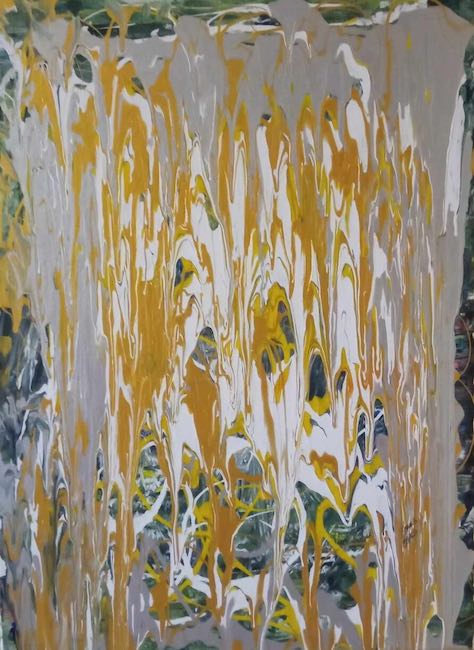
Ed è per questo che lo stile pittorico scelto è quello della mancanza di forma riconoscibile, per dare libero sfogo a tutto ciò che in precedenza era rimasto inespresso, per raccontare il suo personale punto di vista su tutto ciò che colpisce la sua sensibilità artistica rivelando al contempo un carattere dinamico, eclettico, positivo e determinato che opera dopo opera mostra tutte le sue sfaccettature.
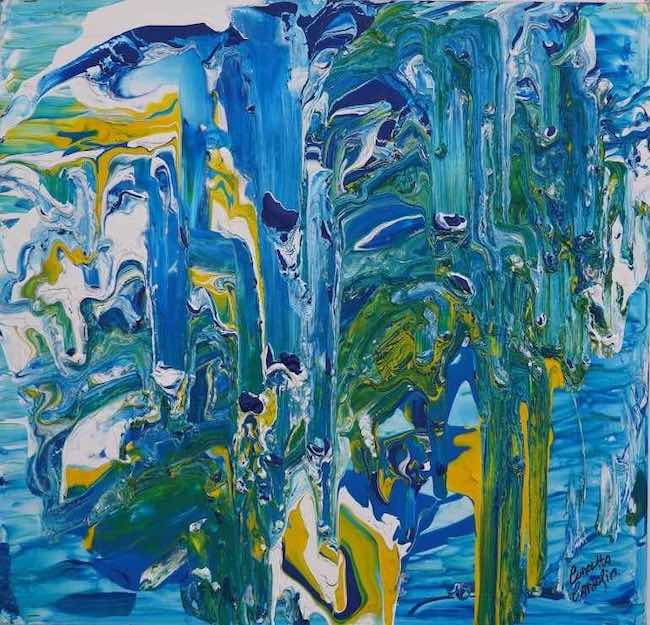
La tela Ricco Mare gioca con tutti i colori dell’acqua marina, della schiuma delle onde, della sabbia su cui si infrangono, ed è contraddistinto da una forte luminosità ma anche da un’estrema concretezza poiché il colore è steso in modo denso, quasi materico, come se Concetta Cantafio volesse dare spessore alle emozioni provate davanti a ciò che i suoi occhi sono abituati a vedere da sempre, quell’incontro tra l’azzurro delle acque cristalline e il giallo della spiaggia. In questo caso il supporto scelto non è la tela, bensì il legno, a conferma di quanto il percorso espressivo di questa artista sia una costante sperimentazione, un continuo misurarsi con materiali nuovi da esplorare e adeguare al suo estro artistico.
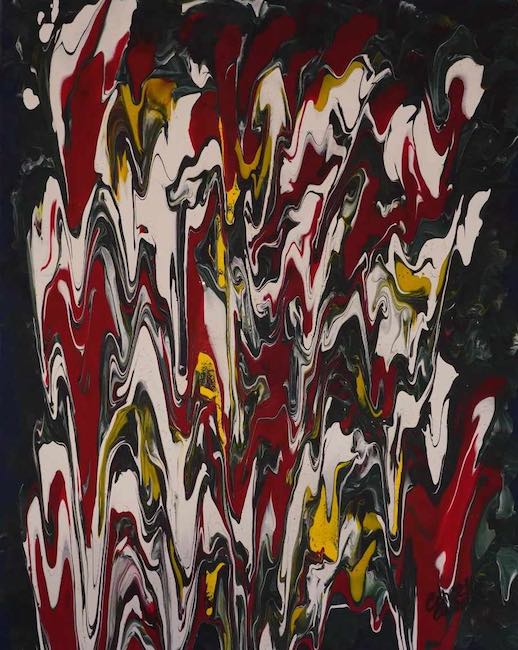
Il Dripping è nuovamente protagonista anche dell’opera Piume in cui il titolo è solo un suggerimento interpretativo della sensazione dell’artista; la morbidezza e la sofficità che il pensiero comune riconduce alle piume infatti sembra essere quasi allontanata dalla Cantafio attraverso la scelta di tonalità forti, intense, scure. Forse perché nel suo punto di vista il piumaggio è usato per nascondere la propria vera essenza, quasi a volerle trasformare in scudo protettivo, oppure al contrario per sottolineare quanto un aspetto apparentemente leggero e impalpabile possa rivelare un’inaspettata resilienza, esattamente come le piume degli uccelli che sono impermeabili e proteggono dal caldo e dal freddo. Il gesto plastico diviene dunque parte stessa dell’opera perché è nel momento dell’azione che Concetta Cantafio riesce a divenire cosciente della parte di sé che desidera rivelare, o di quale punto di vista e riflessione sulla realtà circostante vuole mettere in risalto scegliendo con cura le tonalità che la accompagneranno nel percorso creativo.
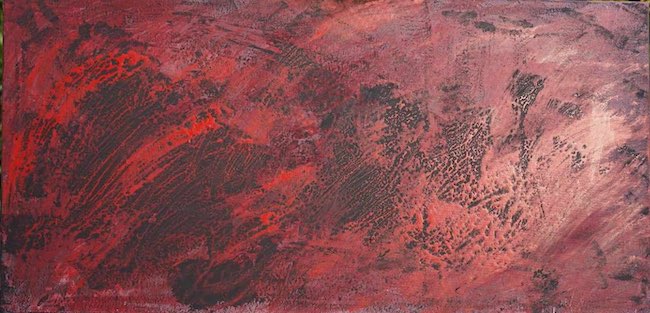
Nelle opere più sperimentali invece il processo espressivo è più analitico, meditato, sembra rallentare il ritmo per permetterle di studiare con cura quale possa essere il materiale in grado di modellare il pensiero che desidera esprimere, e che vada a legarsi al meglio alle altre materie che entreranno a far parte dell’opera; su questa base nasce l’opera Maschio Femmina, una celebrazione della diversità che in fondo appartiene da sempre alla storia dell’uomo, determinata da differenze complementari in grado di costituire un arricchimento, un continuo apprendere l’uno dall’altra modi differenti, se non in alcuni casi divergenti, di affrontare le circostanze.
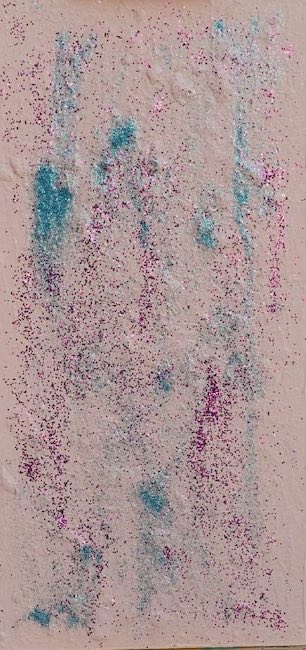
In questa tela le due essenze si mescolano, il glitter, elemento fondamentale dell’opera, azzurro sembra abbracciare e danzare con il rosa come se le due parti fossero unite indissolubilmente, incapaci di staccarsi; la base è costituita invece dallo stucco su legno, quasi a voler indicare la solidità che da quell’unione si va a generare, malgrado la leggerezza del glitter, suggerendo che in fondo le differenze sono meno importanti di tutto ciò che in virtù di esse si possa invece costruire. Concetta Cantafio inizia il suo percorso artistico da autodidatta, dopo essersi occupata per molti anni della direzione della sua azienda di famiglia, ma il suo lato creativo necessita fin da subito di esprimersi velocemente, concitatamente, producendo dunque molte opere che hanno già riscosso grande attenzione tra il pubblico, i collezionisti e gli addetti ai lavori.
CONCETTA CANTAFIO-CONTATTI
Email: cantafioconcetta1969@gmail.com
Facebook: https://www.facebook.com/concetta.cantafio.9
Instagram: https://www.instagram.com/cantafioconcettazeus/
The sparkling and vivacity of life’s experiences and sensations in Abstract Expressionis, by Concetta Cantafio
The paths of existence often constitute the modality through which an artist approaches art, at times revealing his character qualities and at others concealing them, based on the attitude towards reality, towards objectivity, that each creative person has; where some need to rationalise every small circumstance others prefer to study the observed in order to better understand themselves and the world around them. In the same way, there are those who need to have a completely analytical and scientific approach while others completely free themselves of all shyness or expressive reticence only in impulsive and spontaneous contact with the canvas. Today’s protagonist belongs to the last group, the one for whom the relationship with painting is a manifestation of the deeper self that finds its true essence in colours and artistic experimentation, revealing the gaze with which she places hersfelf towards existence.
The expressive journey of the 20th century was a constant succession of innovations, avant-gardes and experiments that in all previous art, absolutely bound to classical and academic rules, had never been able to take place; the limits imposed by a millenary pictorial tradition, the search for formal perfection and the rendering of observed reality, were completely broken in the face of the need for something new that was sweeping over the entire cultural world of early 20th-century Europe like a wave, driven by the radical changes that society was undergoing but above all by the artists’ desire to find new lifeblood necessary to nourish a creativity that no longer wanted to be subject to any scheme or rule. Expressionism emphasised the desire of some to abandon representational perfection and turn to an interiority that had been ignored for too long, if not for a few exceptions, until the end of the 19th century, thus leading to a renunciation of aesthetic beauty in favour of a predominance of strong, intense, even overwhelming emotion at times. This trend initially found opposition and obstacles in the cultural salons of the time, but then thanks to the tenacity of great masters of the genre, such as Henri Matisse, André Derain, Edvard Munch and James Ensor, closures were broken down and the movement became predominant in the early 20th century. But the innovation of that period also pushed towards a complete renunciation of the visible form, of a reproduction of reality that had dominated too much before and that now had to be confronted with the new technological means that were emerging such as photography and cinema.
Thus another group of artists found a way to affirm the supremacy of art above all else, decreeing the birth of Abstract Art, declined in Lyrical Abstractionism, De Stijl, Russian Suprematism, Constructivism, Geometric Abstractionism, where, however, what masters such as Piet Mondrian, Kasimir Malevic and Josef Albers aimed for was the complete renunciation of the author’s subjectivity, of emotional detachment to emphasise the perfection of the plastic gesture purged of all sensation. However, excluding the inner world did not generate sufficient involvement in the public, so in the United States in the 1950s, a group of artists led by Jackson Pollock decided to allow Abstractionism to reappropriate emotion, giving birth to Abstract Expressionism, where even the action of painting became part of the canvas for the first time and where stylistic freedom was one of the guiding principles of the movement. What counted above all else was to convey on the work the restrained interiority and at times incapable of finding a language as explicit as pictorial, despite the indefiniteness of the images; this is exactly the path that distinguishes the Calabrian artist Concetta Cantafio, who chooses Abstract Expressionism to give concreteness to all the sensations she receives from the reality around her and which are filtered through her positive approach to life. But her creative need, characterised by a marked multifacetedness, pushes her to measure not only with the pure pictorial impulse that places her on the same instinctive level as Pollock, but also with the material that must be moulded and indulged in her instincts, generating artworks of strong impact sometimes marked by a darker chromatic range, emphasising how existence is also sometimes a bearer of shadows that must be faced, looked into the eyes and only later resolved, while others are characterised by greater luminosity and a more open and smiling choice of colour.
The visions, dreams, and interpretations that Concetta Cantafio gives to the reality that surrounds her emerge with all their spontaneity, without setting herself executive limits or submitting to expressive rules, because what she wants is simply to let flow a creative intuition that for a long time has been left in silence, perhaps because daily commitments prevented her from cultivating it until the day she decided to indulge that irrepressible inner drive. And this is why the painting style she has chosen is that of a lack of recognisable form, to give free rein to everything that had previously remained unexpressed, to tell her personal point of view on everything that strikes her artistic sensibility while revealing a dynamic, eclectic, positive and determined character that work after work shows all its facets. The canvas Ricco Mare (Rich Sea) plays with all the colours of seawater, of the foam of the waves, of the sand on which they break, and is characterised by a strong luminosity but also by an extreme concreteness because the colour is spread in a dense, almost material way, as if Concetta Cantafio wanted to give depth to the emotions felt in front of what her eyes have always been used to seeing, that encounter between the blue of the crystal-clear waters and the yellow of the beach. In this case, the chosen medium is not canvas but wood, confirming how much this artist’s expressive path is one of constant experimentation, a continuous measuring up against new materials to explore and adapt to her artistic flair. Dripping is again the protagonist of the painting Piume (Feathers) in which the title is only an interpretative suggestion of the artist’s sensation; the softness and fluffiness that common thought ascribes to feathers in fact seems to be almost distanced by Cantafio through the choice of strong, intense, dark tones. Perhaps because in her view, feathers are used to conceal their true essence, almost as if to turn them into a protective shield, or on the contrary to emphasise how an apparently light and impalpable aspect can reveal an unexpected resilience, just like bird ones, which are impermeable and protect against heat and cold.
The plastic gesture thus becomes part of the artwork itself because it is in the moment of action that Concetta Cantafio is able to become aware of which part of herself she wishes to reveal, or which point of view and reflection on the surrounding reality she wishes to emphasise by carefully choosing the tones that will accompany her along her creative path. In the more experimental works, on the other hand, the expressive process is more analytical, meditated, it seems to slow down the pace to allow her to carefully study what material could be capable of modelling the thought she wishes to express, and which would be best bonded with the other materials that will become part of the painting.
This is the basis for the artwork Male Female, a celebration of diversity that has always belonged to the history of mankind, determined by complementary differences capable of constituting an enrichment, a continuous learning from each other of different, if not in some cases divergent, ways of dealing with circumstances. In this canvas the two essences mingle, the glitter, fundamental element of the composition, blue seems to embrace and dance with the pink one as if the two parts were inextricably united, unable to detach themselves; the base is instead made of stucco on wood, almost as if to indicate the solidity that is generated by that union, despite the lightness of the glitter, suggesting that in the end the differences are less important than anything that can be built on the basis of them. Concetta Cantafio began her artistic career as a self-taught artist, after having been involved in the management of her family business for many years. However, her creative side immediately needed to express itself quickly, concisely, thus producing many artworks that have already attracted great attention among the public, collectors and insiders.


